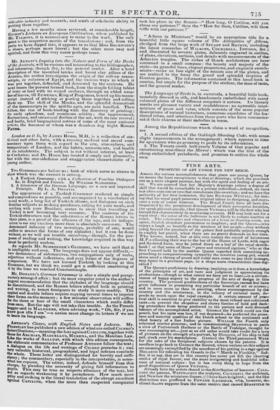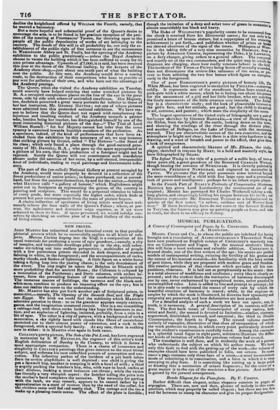FINE ARTS.
PROSPECTS OF ART UNDER THE NEW REIGN.
AMONG the various accomplishments that grace our young Queen, by no means the least conspicuous is that of drawing ; which she practises not as a mere elegant pastime, but with the spirit and feeling of an art- is:t. We are assured that her Majesty's drawings evince a degree of skill that would be remarkable in a private individual—indeed, we have our ,elves seen one or two that corroborate this assertion ; and we have the authority of her first instructor, the late RICHARD WLSTALL, for stat- ing that his royal pupil possesses original talent in designing, and more- over a vein of comic humour. The Royal Family have all been dis- tinguished by the prominent development of their perceptive faculties, (to speak plirenologically,) but Queen VICTORIA will be the first who has turned this characteristic to an aniusing account. HB may look out for a royal rival : the sense of the ludicrous is not likely to remain inactive at court. The ceremonies and characters of a levee or drawing-room, we opine, furnish abundant provocation to laughter; and the Queen—who enjoys a laugh as heartily as the merriest of her people—may without going beyond the precincts of the palace find quizzable subjects enough to employ her pencil, when there are no graver demands on her time. Who knows, indeed, but at this very instant the crowd of boisterous M. P.s elbowing their way to the bar of the House of Lords, with eager and flustered faces, may be jotted down on a leaf of the royal sketch- book ? or that some of those "grave and reverend signiors," who at the first Council held by the maiden Queen regarded with something ap- proaching to compassionating sympathy the sensitive young girl, seated alone amid a throng of proud and noble men come to pay their homage, may figure in a previous page, in a shape more characteristic than dig- allied?
The Queen's proficiency in drawing, implying, as it does, a knowledge of the principles of art, and taste and judgment in appreciating its productions—though to what extent we have yet to learn—is a circum- stance of happy augury to the progress of the arts of design in this country. The personal predilections of the Sovereign cannot but have great influence in promoting any particular branch of art or science; and in none more so than in painting, whose encouragement by the country and the aristocracy, in the infancy of national taste, de- pends so much upon the royal example. A certain amount of prac- tical skill is essential to give stability to the most refined and cultivated taste—to prevent the shapeless and showy fancies of bold and dash- ing pretenders from being preferred to the patient and well-directed labours of the accomplished artist. GEORGE the Fourth could use the pencil, but his taste was low, if not depraved—he preferred the gross- ness and material qualities of the Dutch school to the sentiment and
ideal beauty of a fine Italian picture. WILLIAM the Fourth Only tolerated marine pictures; and in commissicming STANFIELD to paint a view of Portsmouth Harbour or the Battle of Trafalgar, thought be was encouraging art,—just as an old sailor would take credit for a love of pictures on the strength of a portrait, by HUGGINS, of his ship in full sail, stuck over his mantelpiece. GEORGE the Third patronised WEST for the sake of the Scriptural subjects chosen by the painter. It ma
needless to go back to GEORGE the Second, whose notions on this subject are amusingly exemplified by the anecdote of his getting in a rage against HoGARTH for ridiculing his Guards in the "March to Finchley." Suf- fice it to say, that art in this country has never yet felt the cheering ring smiles of royal favour, nor the more invigorating and healthful influ- ence of national culture : but it has every thing to hope from the good dispositions of Queen VICTORIA. Already have the artists shared in the distribution of honours: CALL- CoTT the painter, WEsTmAcOTT the sculptor, Cociceitm the architect, and NEWTON the miniature-limner, (!) have been knighted ; and the like distinction was proffered to EDwAall LANDSEER, who, however, ae- dined it—We suppose from the Same motive that caused STANFLELD
decline the knighthood offered by WILLIAM the Fourth, namely, that be wanted a baronetcy.
But a more hopeful and substantial proof of the Queen's desire to encourage the arts, is to be found in her gracious reception of the peti- tion of the meeting at Freemasons' Tavern, for throwing open to the people all the public depositories of works of art belonging to the country. The result of this will in all probability be, not only the es- tablishment of the public right of free entrance to see the monuments in Westminster Abbey and St. Paul's, but the opening of the Academy exhibition to the public gratuitously—unless the Royal Academy choose to vacate the building which it has been suffered to usurp for its own private advantage. Upwards of £7,000, it is said, has been received this year at the doors of the National Gallery, by the keepers of the Academy show-shop,—just about one-tenth part of what the building cost the public. At this rate, the Academy would drive a roaring trade, to the destruction of their competitors who have to provide or pay rent for galleries of their own, and who have not the advantage of the Academy prestige. The Queen, when she visited the Academy exhibition on Tuesday, could scarcely have helped noticing that some wretched pictures by R. A.s occupied conspicuous places on the line of the eye in the great room, side by side with others of unrivalled excellence. Her Majesty, too, doubtless perceived a great many portraits far inferior to those of her last instructor, Mr. GEORGE HAYTER ; not one of whose pictures were admitted into this pretended national exhibition. We have rea- son to believe that the Queen does not regard with complacency the injurious and insulting conduct of the Academy towards a painter who, besides being her teacher, has distinguished himself by one of the most interesting historical pictures of the day—" The Trial of Lord William Russell : " for her Majesty cannot but infer that the same tyranny is exercised towards humbler members of the profession. As • specimen, indeed, of the kind of performances that have been ex- cluded from the exhibition by this autocracy of art, we may instance that striking picture by GUDIN, called " The Distress "—the finest of its class ; which only found a place through the good-natured gene- rosity of Mr. DANIELL, R. A.; who gave up the space appropriated to a picture of his own, that this production of a foreigner might not be rejected. Surely the Queen will not countenance such scandalous abuses under the sanction of her name, by a self-elected, irresponsible knot of individuals, trading in royal patronage and Government influ- ence.
The part of the (so-called) National Gallery at present occupied by the Academy, would more properly be devoted to a collection of the finest productions of native artists ; in future purchased, not at second- hand, but from the painters themselves, by and for the nation,—forming what HAYDON calls "a gallery of honour," which Englishmen might point out to foreigners as representing the genius of the country in painting and sculpture. This would be a perpetual stimulus to talent of every grade, but more especially the higher older, which finds at present but poor encouragement from the mass of picture-buyers. A choice collection of specimens of living artists would most Avel-
comely relieve the bare walls of the Queen's Palace ; where, at pre- sent, the upholsterer and decorator reign supreme, as if art were ashamed to show its face. If space permitted, we would indulge our- selves by sketching an outline plan of a Royal Gallery of the works of living artists.



























 Previous page
Previous page